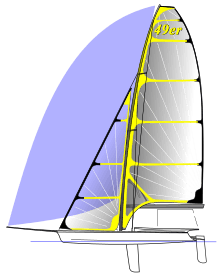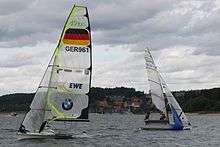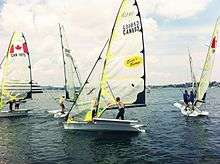49er (dinghy)
|
Class symbol | |
 | |
| Boat | |
|---|---|
| Crew | 2 (double trapeze) |
| Draft | 1,447 mm (4 ft 9 in) |
| Hull | |
| Hull weight | 94 kg (207 lb) |
| LOA | 4,876 mm (16 ft) |
| Beam |
without wings: 1,752 mm (5 ft 9 in) with wings: 2,743 mm (9 ft 0 in) |
| Sails | |
| Spinnaker area | 37.16 m2 (400 sq ft) |
| Upwind sail area | 19.97 m2 (215 sq ft) |
| Racing | |
| D-PN | 68.2[1] |
| RYA PN | 710[2] |
| Current Olympic equipment | |
The 49er and 49er FX is a two-handed skiff-type high-performance sailing dinghy. The two crew work on different roles with the helm making many tactical decisions, as well as steering, and the crew doing most of the sail control. Both of the crew are equipped with their own trapeze and sailing is handled while "flying".
The 49er was designed by Julian Bethwaite (the son of Frank Bethwaite) and developed by a consortium consisting of Bethwaites, Performance Sailcraft Japan, Peter Johnston, and Ovington boats.[3] The boat has been an Olympic class since it was selected by the International Sailing Federation after a series of trials to be the men's high performance double handed dinghy Sydney Summer Games of 2000. Its derivative featuring a re-designed rig, the 49er FX, was selected by ISAF to be the women's high performance double-hander at the Rio Summer Olympics of 2016.
History
The 49er's name comes from its hull length of 4.99 metres. It incorporates ideas developed in Julian Bethwaite's 18ft Skiffs, notably the Prime Computer series of boats, which were double handers.[4]
For a controllable and fast gust response, the mast was tuned to deflect from the top downwards with an increase in wind speed, causing the upper main to twist off and flatten, reducing the heeling moment. The use of solid wings, rather than tubes as on similar boats (RS800 etc.), makes it easier for the crew to run across the deck from gunwale to gunwale during maneuvers.


The 49er made its first Olympic appearance at the Sydney Olympics in 2000 and has continued to grow in popularity ever since.
With a Portsmouth yardstick Handicap of 710 the 49er is the fastest two person one-design monohull dinghy.
In 2009 the boat received a new rig design, including a larger fully carbon mast (replacing the aluminum mast) and square top (roach) mainsail.[5]
Construction
As a one design class, the 49er has two licensed suppliers, Mackay Boats in Australasia and Ovington in the UK.
Hull
The hull is made of Epoxy GRP and foam sandwich laminate with carbon fibre in high load areas. It includes two solid wings, also called racks, that clip into the side to increase righting moment of the trapezing crew.[6] Its length was fixed at 4.99 metres because the ISAF brief for the high performance Olympic class dinghy called for a 5-metre boat, but Tokao Otani, a member of the development consortium, pointed out that there was a tariff in Japan for boats over 5 metres long.[3] It has a fine entry to efficiently transition between the low speed displacement, and high speed planing modes.[7] According to the International 49er class rules, the minimum hull weight including all permanent fittings can not be less than 94.0 kg.[8]

Spars
Southern Spars, part of the North Technology Group, is the licensed supplier of the 49er mast. It is a three piece male-moulded assembly made from 100% standard modulus carbon.[9] It is 7.0 meters tall and capable of supporting a combined crew weight up to 165 kg from its dual trapeze. The mast is braced by three sets of shrouds that connect to a fitting on the side of the boat. The crew is able to adjust them by tightening or loosening them, depending on the wind speed and sea states.[10]
The boom is made from an aluminium alloy extrusion.
Foils
The rudder and daggerboard are made out from a composite of epoxy, carbon and glass, covered by a hard gelcoat surface. The head of each class legal foil carries the embossed 49er logo and the ICA label.[8]
Sails
The 49er contains three sails: a main sail, jib, and spinnaker. The main and jib are 20 square meters, fully battened and made of reinforced Mylar (film polyester). The main was redesigned in 2007 from a full, curved roach plan to having a square on top in order to provide more sail area and to control more shape adjustment. The spinnaker is 38 square meters in a tri-radial asymmetric shape.[6]
Events
Olympics
Men's 49er
Women's 49er FX
Games |
Gold | Silver | Bronze |
|---|---|---|---|
| 2016 Rio de Janeiro |
Martine Grael Kahena Kunze |
Alex Maloney Molly Meech |
Jena Mai Hansen Katja Salskov-Iversen |
World Championships
Men's 49er
Year |
Gold | Silver | Bronze |
|---|---|---|---|
| 2013 Marseille | Peter Burling Blair Tuke |
Marcus Hansen Josh Porebski |
Manu Dyen Stéphane Christidis |
| 2014 Santander |
Peter Burling Blair Tuke |
Jonas Warrer Anders Thomsen |
Nathan Outteridge Iain Jensen |
| 2015 Buenos Aires |
Peter Burling Blair Tuke |
Nathan Outteridge Iain Jensen |
Federico Alonso Arturo Alonso |
| 2016 Clearwater[11] | Peter Burling Blair Tuke |
Nico Delle Karth Nikolaus Resch |
Dylan Fletcher-Scott Alain Sign |
| 2017 Matosinhos[12] |
Dylan Fletcher-Scott Stuart Bithell |
James Peters Fynn Sterritt |
Benjamin Bildstein David Hussl |
| 2018 Aarhus[13] |
Šime Fantela Mihovil Fantela |
Mathieu Frei Noé Delpech |
Tim Fischer Fabian Graf |
Women's 49er FX
Year |
Gold | Silver | Bronze |
|---|---|---|---|
| 2013 Marseille | Alex Maloney Molly Meech |
Martine Grael Kahena Kunze |
Sarah Steyaert Julie Bossard |
| 2014 Santander |
Martine Grael Kahena Kunze |
Ida Marie Baad Nielsen Marie Thusgaard Olsen |
Giulia Conti Francesca Clapcich |
| 2015 Buenos Aires |
Giulia Conti Francesca Clapcich |
Martine Grael Kahena Kunze |
Ida Marie Baad Nielsen Marie Thusgaard Olsen |
| 2016 Clearwater[14] | Támara Echegoyen Berta Betanzos |
Maiken Foght Schütt Anne-Julie Schütt |
Victoria Jurczok Anika Lorenz |
| 2017 Matosinhos[12] |
Jena Mai Hansen Katja Salskov-Iversen |
Martine Grael Kahena Kunze |
Alexandra Maloney Molly Meech |
| 2018 Aarhus[15] |
Annemiek Bekkering Annette Duetz |
Tanja Frank Lorena Abicht |
Sophie Weguelin Sophie Ainsworth |
Related boats
The 49er FX was developed by Mackay Boats to be a women's Olympic class. It consists of a 49er hull, wings, and foils, with a scaled down rig designed to suit the weight of an elite female crew.
The 29er is a smaller, single trapeze trainer to the 49er. It has become popular in North America, Europe and Australia as a fast youth boat. Recently the 29erXX, a twin trapeze version of the 29er, has been produced with a rig very similar to the 49er.
The 59er dinghy was put into production in Australia and the UK in 2002. It is a non-trapeze, 4.7m (15 feet 5 inches) sailing dinghy, rigged with an asymmetric spinnaker. It is designed for a crew weight of 145 kg to 180 kg (320 lb to 400 lb).
References
- ↑ "Centerboard Classes". US Sailing. Archived from the original on 15 March 2012. Retrieved 31 July 2012.
- ↑ "Portsmouth Number List 2017". Royal Yachting Association. Archived from the original on 2017-03-23. Retrieved 22 March 2017.
- 1 2 Frank., Bethwaite, (2008). Higher performance sailing. London: Adlard Coles Nautical. ISBN 9781408101261. OCLC 854680844.
- ↑ http://forums.sailinganarchy.com/index.php?showtopic=163903
- ↑ "Archived copy". Archived from the original on 2010-01-27. Retrieved 2010-01-26.
- 1 2 "Archived copy". Archived from the original on 2015-05-18. Retrieved 2015-05-08.
- ↑ http://49er.org/class-info/the-boat/design-elements/
- 1 2 http://www.sailing.org/tools/documents/49er2015CR160115-%5Bpermanent+dead+link%5D[18262].pdf
- ↑ http://www.mackayboats.com/mackayboats/assets/File/49erUsers%20Manual%202010%20%20%5BCompatibility%20Mode%5D.pdf
- ↑ "Archived copy". Archived from the original on 2012-06-28. Retrieved 2015-05-08.
- ↑ "2016 World Championship". 49er.org.
- 1 2 "2017 World Championship in Porto". 49er.org.
- ↑ "2018 World Championship in Aarhus". manage2sail.com.
- ↑ "2016 World Championship". 49er.org.
- ↑ "2018 World Championship in Aarhus". manage2sail.com.
External links
| Wikimedia Commons has media related to 49er. |